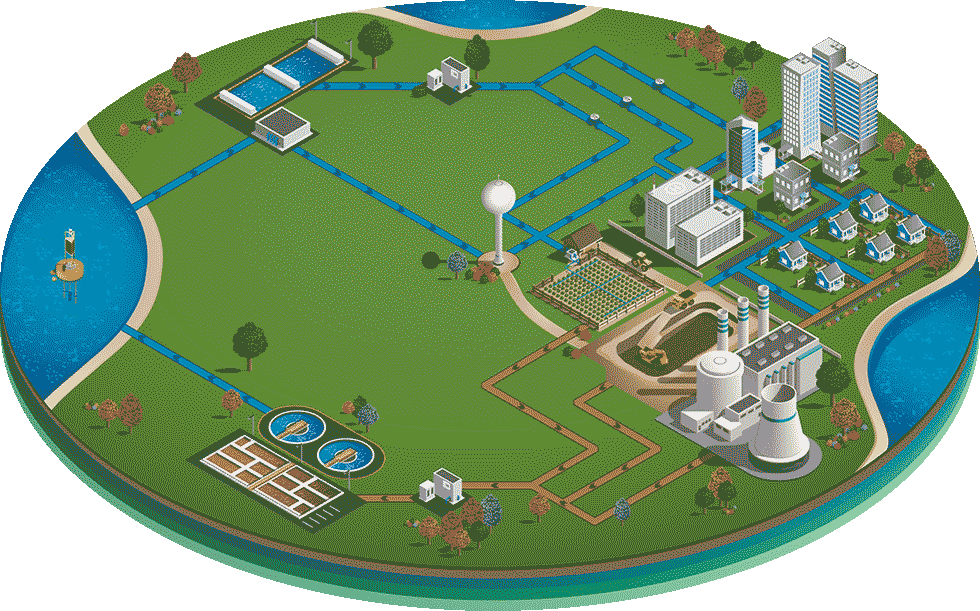
In everyday life, homeowners perform many tasks involving water, such as flushing the toilet or doing laundry, but where does all the waste end up? Ultimately, it heads to a municipal facility or wastewater treatment plant, although the journey can vary.
In residential areas, homes are usually connected to a sewer line or main. In most cases, waste flows directly into the sewer line through the force of water pressure and gravity. However, in certain scenarios—such as homes with basements or properties located below the sewer main level—sewage pumps or grinder pumps may be necessary to counteract gravity. These pumps collect waste and transfer it to the sewer main or a designated collection area.
Alternatively, homes without access to a sewer line utilize septic systems. These systems consist of a septic tank and a drain field. Waste accumulates in the septic tank, forming distinct layers—sludge at the bottom, scum at the top and effluent in between. Effluent exits the tank via an outlet baffle, either by gravity or with the assistance of an effluent pump. The effluent then flows into the drain field, where perforated piping disperses the liquid into the soil for natural decomposition by aerobic bacteria (aerobic: relating to, involving or requiring free oxygen). If the soil is unsuitable, alternative systems like mound or sand filters may be installed.
Regardless of the system used, adherence to local codes is crucial during installation. Eventually, the septic tank fills with solids and must be emptied by a licensed professional. The collected waste is transported to wastewater treatment plants for proper disposal and treatment.
In terms of composition, wastewater comprises 99.9% water, with the remaining 0.1% containing components like organic matter, microorganisms (potentially pathogenic) and inorganic compounds.
Following its journey through collection lines, wastewater undergoes preliminary treatment at the headworks building of the treatment plant. This involves fine screening to remove debris and grit removal to eliminate heavier materials. Nutrient removal involves blending the influent with return activated sludge (RAS) in anaerobic selector tanks. This process selects desired bacteria while excluding unwanted ones like filament bacteria. Anaerobic conditions, which are those lacking oxygen, are crucial for this process.

There are some important terms to know regarding the conventional treatment of wastewater:
Biochemical oxygen demand (BOD)
This refers to the amount of dissolved oxygen needed by microorganisms to break down organic matter in wastewater.
Mixed liquor
This term is used to describe the combination of microorganisms and wastewater within the oxidation ditch.
BOD treatment
The mixed liquor undergoes aeration to supply oxygen to the microorganisms, enabling them to aerobically convert BOD into carbon dioxide (CO2) and water (H2O). The wastewater circulates within the ditch for approximately 33.6 hours, continuously undergoing this treatment process.
Nutrient removal in oxidation ditch
The mixed liquor, consisting of RAS and influent, enters the oxidation ditch, where the wastewater’s nutrients are targeted for treatment.
Nitrification
This process involves the biological conversion of ammonia (NH3) to nitrate (NO3). It occurs in two stages: ammonia oxidation and nitrite oxidation, facilitated by different groups of bacteria. Oxygen is introduced in zones 2 and 3 of the oxidation ditch, rendering the mixed liquor aerobic to effectively treat ammonia. Ammonia is sequentially converted to nitrite and then to nitrate.
Denitrification
Denitrification entails the conversion of nitrate to nitrogen gas. This occurs in zones 1 and 4 under anoxic conditions—meaning there is no oxygen, but nitrate is present. Denitrification is initiated when there is an organic food source available.
Clarification process
The mixed liquor transitions from the oxidation ditch to the clarifier. Within the clarifier, solids settle at the bottom while grease rises to the top. The clarified water remains in the middle and proceeds over the weirs toward the final disinfection stage.
Scum arms
Two scum arms skim the surface of the clarifier to remove any accumulated scum from the process.
Baffles
Baffles are employed to prevent scum and solids from bypassing the settling process, ensuring effective clarification.
Solids
Solids have two destinations. A calculated portion of solids is returned to the oxidation ditch as RAS, where it continues to treat the raw wastewater. The remaining solids, known as waste activated sludge (WAS), are designated for disposal in the solids processing building. There, they undergo final treatment and dewatering.
In the wastewater treatment process, significant quantities of sludge are generated and require proper disposal. One method available for treating this sludge involves thickening it using polymers and solid bowl centrifuges. After undergoing the thickening process, the sludge can contain up to 20% to 24% dry solids. This process significantly reduces the volume of active sludge waste by over 80% and decreases the sludge amount through digestion by 30% to 40%. Reducing the disposal of sludge also leads to lower polymer costs and enhances the characteristics for dewatering.
The final step in the treatment process involves disinfection. High-wattage ultraviolet lights are employed to kill and inactivate microorganisms and pathogens. Pathogens are microorganisms that cause diseases and have the ability to reproduce independently. They produce toxins and can harm the cells they invade. Subsequently, the flow of the effluent is measured before it is safely discharged from the plant into the river.
Submersible Solutions is produced by the Submersible Wastewater Pump Association to inform and educate in the design and operation of submersible wastewater pumping systems. For more information, visit pumpsandsystems.com/swpa.

